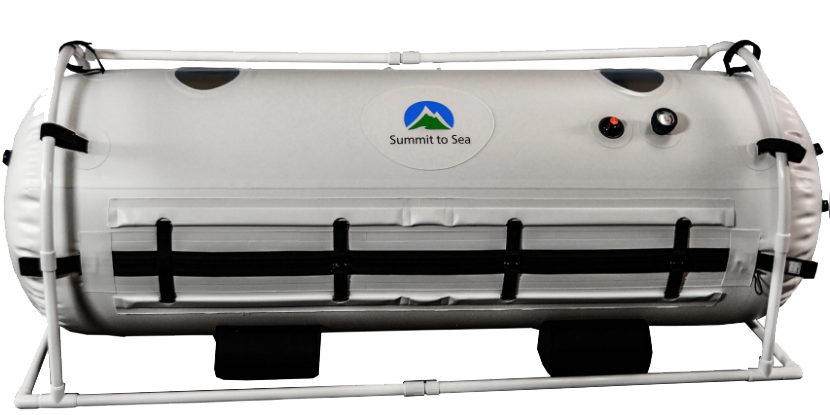Hyperbaric Oxygen Therapy
Hyperbaric Oxygen Therapy can help improve the body's oxygen supply, promoting healing and regeneration of damaged tissues.

What is Hyperbaric Oxygen Therapy?
Hyperbaric Oxygen Therapy (HBOT) is a non-invasive and painless treatment that involves the inhalation of 100 % pure oxygen in a pressurized chamber. It provides a relaxing environment for patients to rest and rejuvenate. Based on the laws of physics, breathing oxygen under pressure allows the oxygen to be dissolved into the plasma of the red blood cells, allowing at least 4 times more oxygen to be transported via the bloodstream into the tissues to damaged tissues to facilitate the healing process. If you're experiencing mental health conditions, cognitive decline, memory problems or are recovering from a concussion or traumatic brain injury (TBI), HBOT may be an ideal treatment option. This increasingly popular therapy has shown promising results in helping people recover from a range of conditions and improve their overall wellbeing.
At Whole Body Wellness, we offer Summit to Sea’s Dive (FDA-cleared), a low-pressure or mild chamber (mHBOT) to enhance the body’s innate ability to repair and regenerate. It is used as an adjunct therapy to complement and enhance the healing processes in both chronic and acute conditions.
Hyperbaric Oxygen Therapy has been found to be particularly suited for the following “off-label” uses:
|
|
History of Hyperbaric Oxygen Therapy
Hyperbaric oxygen therapy (HBOT) has a long history, with roots dating back to the late 1600s. The first recorded use of pressurized air in medicine was by the English physician, Henshaw, who constructed a chamber in which he subjected patients to compressed air in 1662. However, it wasn't until the late 1800s that HBOT began to gain acceptance as a legitimate medical treatment.
In the early 1900s, several physicians and scientists began experimenting with oxygen as a treatment for various medical conditions. In 1917, a French physician named Paul Bert published a book on the medical use of high-pressure oxygen, and in 1928, a German physician named Orville Cunningham published a report on the use of HBOT for decompression sickness in divers.
During World War II, HBOT was used extensively to treat divers suffering from decompression sickness, and to improve healing in soldiers with wounds and burns. After the war, the use of HBOT expanded to include a variety of medical conditions, including carbon monoxide poisoning, gangrene, and diabetic ulcers. Today, HBOT is recognized as a safe and effective treatment for a wide range of medical conditions, including chronic wounds, carbon monoxide poisoning, radiation injury, and many others.
Goals and Principles of the Treatment
Hyperbaric oxygen therapy (HBOT) is a non-invasive treatment that involves the inhalation of pure oxygen while inside a pressurized chamber. HBOT works by increasing the amount of oxygen in the body, which can help to promote healing, reduce inflammation, and improve circulation. This therapy has been used for decades to treat a variety of conditions and is increasingly being recognized as an effective treatment option by the medical community.
One of the key benefits of HBOT is that it can help to reduce inflammation throughout the body. Inflammation is a natural response to injury or infection, but when it becomes chronic, it can contribute to a variety of health problems. By reducing inflammation, HBOT can help to alleviate pain and promote healing in a range of conditions, including chronic pain, autoimmune disorders, and even cancer.
HBOT can also improve circulation by increasing the amount of oxygen that is delivered to tissues throughout the body. This can be especially beneficial for patients with circulatory problems or those who have experienced tissue damage or injury. By improving circulation, HBOT can help to promote healing and reduce the risk of complications such as infections or amputations.
In addition to these benefits, HBOT has also been shown to be effective in treating a range of other conditions, including traumatic brain injury, stroke, and even certain types of infections. While more research is needed to fully understand the potential benefits of HBOT, many patients report feeling better and experiencing improved symptoms after undergoing treatment.
At our naturopathic clinic, we believe in providing our patients with the most advanced and effective treatments available. That's why we offer hyperbaric oxygen therapy as part of our comprehensive approach to healing and wellness. Whether you're dealing with a chronic condition or simply looking to improve your overall health and well-being, HBOT may be the solution you've been looking for.
What to expect at your first Hyperbaric appointment
During a typical HBOT session, patients will lie down in a comfortable chamber while pure oxygen is delivered at a higher pressure than what is normally found in the atmosphere. The increased pressure helps the oxygen to dissolve more efficiently in the blood, which allows it to be delivered to tissues throughout the body more effectively.
Prepare for your first treatment:
- Follow instructions from your healthcare provider: Your healthcare provider will provide specific instructions on how to prepare for your HBOT treatment. It's important to follow their guidelines carefully.
- Avoid smoking and alcohol: Smoking and alcohol consumption can decrease the effectiveness of HBOT. It's best to avoid smoking and drinking alcohol for at least 24 hours before your treatment.
- Avoid certain medications: Certain medications can also decrease the effectiveness of HBOT. Your healthcare provider will advise you on which medications to avoid before your treatment.
- Wear comfortable clothing: Wear loose, comfortable clothing that allows you to move freely. Avoid wearing any jewelry or metal items.
- Empty your bladder and bowels: Use the bathroom before your treatment to avoid discomfort during the session.
- Eat lightly before the treatment: Eat a light meal before your treatment to avoid discomfort, but don't eat a heavy meal as this may cause nausea during the treatment.
- Arrive on time: Arrive at the HBOT facility on time for your scheduled treatment. Allow time for any paperwork or preparation that may be required.
By following these guidelines, you can help ensure that you're properly prepared for your HBOT treatment and maximize its potential benefits.

